

The Index is happy to host the scholarly conference “Abstraction before the Age of Abstract Art,” organized by Profs. Elina Gertsman (Case Western Reserve University) and Vincent Debiais (École des hautes études en sciences sociales) with the generous support of the Samuel H. Kress Foundation, the French-American Cultural Exchange Foundation, Case Western Reserve University, and the École des hautes études en sciences sociales. The conference will be held on May 18, 2019; speakers include Jean-Claude Bonne,
Licia Buttà, Vincent Debiais, Thomas Golsenne, Herbert Kessler,
Robert Mills, and Cécile Voyer.
A full schedule and free registration form will be available after April 7 at https://ima.princeton.edu/conferences.

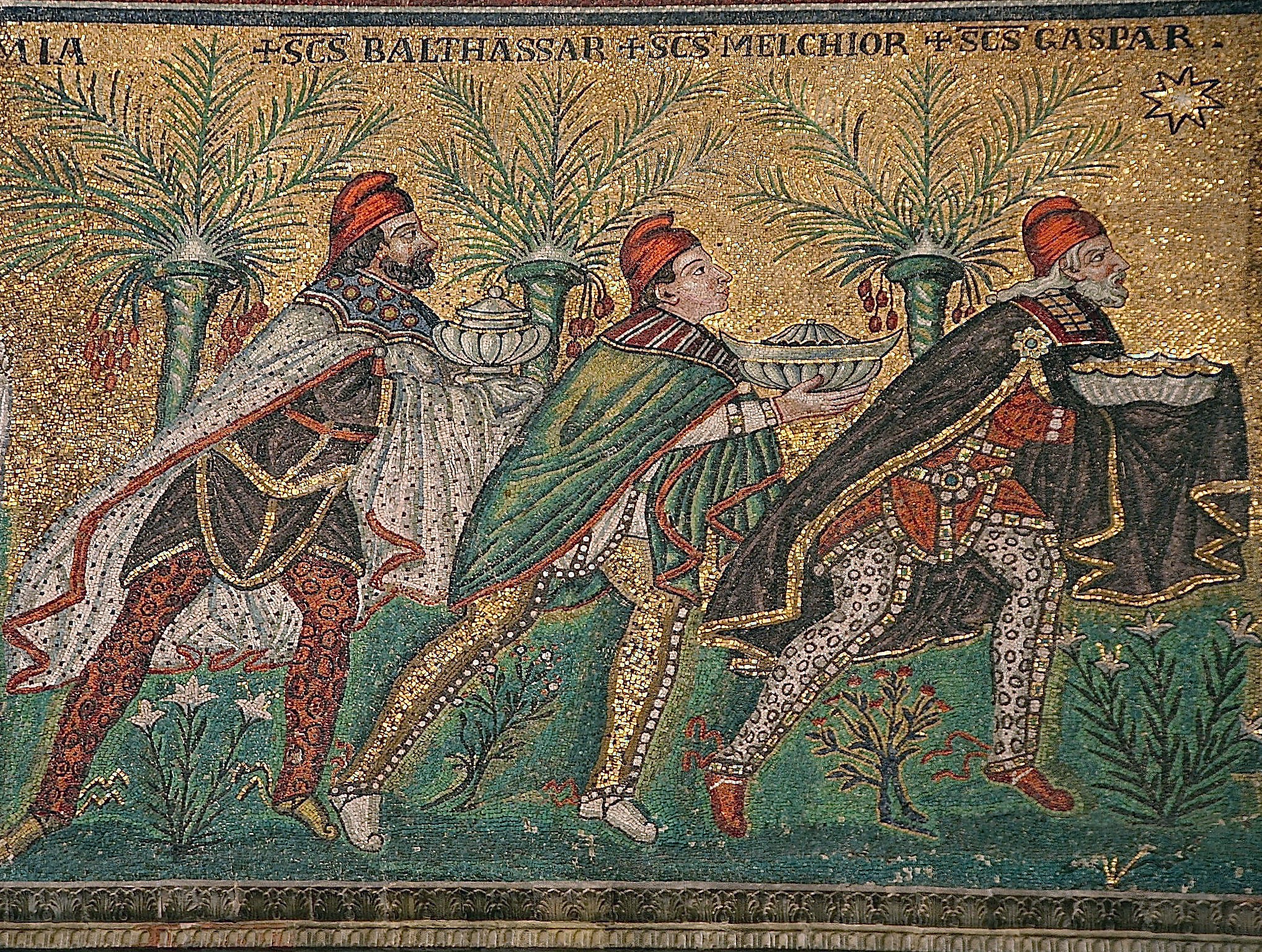
“We three kings of Orient are…” runs the traditional Christmas carol. If you were that kid who wondered “Just who are these guys with their weird-sounding gifts? And where’s ‘Orientare’ anyway?” this blog post is for you.
The story of the Magi originated in the Gospel of Matthew (2:1-12), which tells of “wise men from the east” (magi ab oriente) who traveled to Jerusalem seeking the king of the Jews after seeing a star portending his birth. When they reached Bethlehem, Matthew recounts, they fell and adored him, offering gifts of gold, frankincense, and myrrh. Although this fairly skeletal story offers few details about how the magi looked or from where “in the east” they hailed, that didn’t stop medieval artists from developing their Biblical story into an elaborate visual tradition.
Matthew offers no information about the number of magi who made the trip to Bethlehem. The tradition of depicting them as a trio predominated from the third century onward, perhaps inspired by the three gifts mentioned in the biblical account. Nonetheless, early medieval depictions of the magi in other numbers, such as two, four, or even six, can occasionally be found. Matthew also remains silent about the magi’s names; the ones with which we are familiar today—Melchior, Caspar, and Balthazar—appear much later, in Byzantine texts and images of the sixth century. One of the earliest such instances is the Adoration of the Magi mosaic in Sant’ Apollinare Nuovo in Ravenna, where the elder, foremost magus is labeled Caspar, rather than Melchior, as more often would be the case in later medieval art.
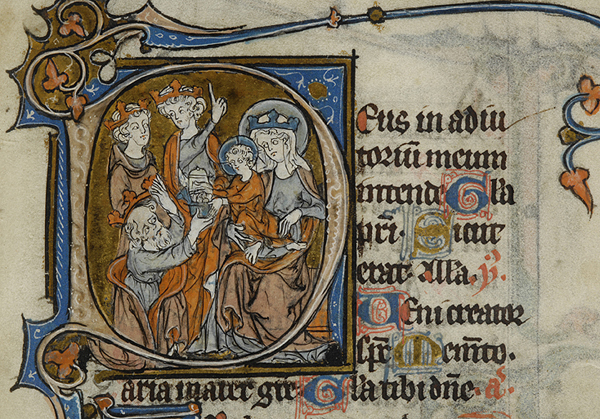
Despite the lack of information about the locations from which the magi came, artists quickly developed ways of visually emphasizing their foreign origins. Early medieval images drew on traditional Roman representations of non-Roman peoples paying homage to the emperor, depicting the magi in appropriately “outlandish” dress such as the short tunics, brightly patterned leggings, and forward-peaked Phrygian caps that appear at Sant’ Apollinare Nuovo. Artistic interest in signaling the magi’s foreign origins corresponded well with Christian exegeses that interpreted the adoration of the magi as symbolic of “heathen” peoples’ recognition of Christ. It was not until the tenth century in western Europe that the magi were reconceived as royal figures, in association with the reference of Isaiah 60:1-4 to the Messiah’s illumination of Gentiles and kings. In many works of art from this point onward, the magi have traded in their traditional caps and trousers for crowns and royal robes, as in the early fourteenth-century Saligny Hours (Morgan Library & Museum, MS. M.60, fol.8r).

From the early Middle Ages onward, the magi were increasingly conceived to be of different ages and geographical origins. In the eighth century, the unknown Irish author nicknamed the “Pseudo-Bede” set down these ideas in writing, describing the magi as of three ages—youth, maturity, and old age—that corresponded to three stages of the life cycle as described by Classical philosophers. Their representation in the ninth-century Stuttgart Psalter (Würtembergische Landesbibliothek, Bibl. Fol. 23, fol. 84r) observes this tradition, depicting them with a white beard, a dark beard, and no beard at all.
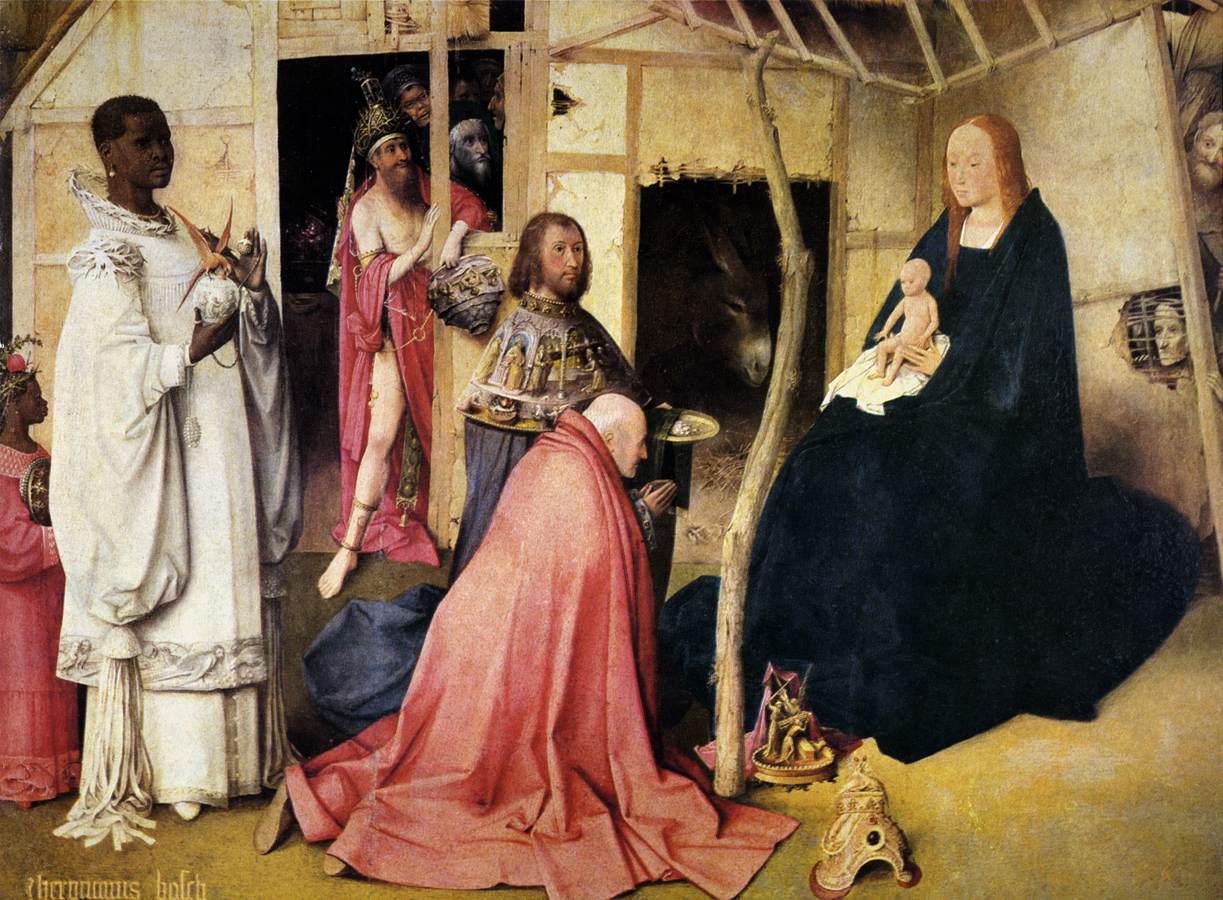
The Pseudo-Bede also described the magi as hailing from the three known parts of the medieval world: Europe, Asia, and Africa. These continents, which formed the basis for the typically tripartite division of medieval T-O maps, were also thought each to have been settled by one of Noah’s three sons, Ham, Shem, and Japeth, with whom medieval thinkers sometimes associated the division of humanity into African, Asian, and European “races.” The late medieval and early modern tradition of representing the magi with ethnic features that European artists tended to associate with each continent—Melchior as a white European, Caspar with Asian features, and Balthazar as a black African—can be traced to this chain of ideas. The opportunity to distinguish the magi as exotic foreigners through their physical appearance as well as through costume and other attributes inspired some of the most elaborate and imaginative portrayals of the later Middle Ages, among them Hieronymous Bosch’s famous 1510 Adoration of the Magi in the Prado Museum. In the Index, many similar images can be found by browsing the subject “Black Magus.”

Extensive image cycles developed around the story of the magi; these illustrate the several stages of their journey, including their questioning of Herod, their sighting of the star, and their arrival in Bethlehem, as well as the dream in which they are warned to avoid Herod and their journey homeward by another route. Over a dozen of these subjects, from “Magi, Adoration” to “Magi, Vision of Christ at Different Ages,” are catalogued in the Index. The most popular subject of all, for medieval and modern viewers alike, is the Adoration of the Magi, depicting the moment when the wise men render homage to the Christ Child in Bethlehem. Portrayals of this event range in both complexity and mood, from the charming, trousered travelers of early Christian tradition to the theatrical processions, replete with angels, gaily costumed servants, and trains of exotic animals (including camels!), of late medieval works like Gentile da Fabriano’s 1423 altarpiece of the Adoration, now in the Uffizi Gallery. Although we still have no idea where these wise guys came from, their presence never fails to bring magic and mystery to the traditional Christmas story.
Someone made each of the works of art described in the Index of Medieval Art, and since the beginning of its online database, The Index has acknowledged the individuals and workshops responsible for generating illuminated manuscripts, sculptures, mosaics, et al. when their identities are known. In the original Index system, artists and scribes each occupied a separate field, however, in the updated Index a new field has been established to incorporate both roles under the title of Creator. This reflects the fact that in some media, such as manuscript illumination, the roles of scribe and artist were not always separate: at times one individual undertook both kinds of work, while in other cases the jobs were more specialized.
The Index here expresses a caveat: Creator will not appear on every record. Medieval artists and scribes were/are largely anonymous, creating unsigned works of art for patrons who were also frequently unknown. However, some of the approximately 1400 creators who are named in the Index are known because they signed their works. Others were acknowledged by patrons who named artisans in their inventories, and still others have been identified by modern art historians who have spotted enough similarities among groups of works to assign a nickname for their otherwise anonymous master.
You can learn more about the artist associated with a particular work of art by looking at the work of art record, where the Creator field is located just toward the bottom. In the example below, a screen shot of a manuscript main record shows the name of Simon Bening as creator.
Click on the name, and another window will open providing information about the creator, including such information as general notes, alternate names, bibliographical citations, profession/s and work of art references. This last bit of information presents a list of all works of art associated by the Index with the artist. In the case of our example Simon Bening, this includes some 250 manuscript folios attributed to the artist and included in our database. The researcher can then click through the records to view these works.

You can also browse by Creator name to see the information and records that the Index includes for a particular Creator. Choose the Browse option on the home page, and from the Browse Indices, click on Creator to open an alphabetical list of names. To find the artist or scribe of interest, either scroll through the list or type the desired name on the line below “Creator” at the top of the list. Click on the correct name, and a window will open as above.

The information about artists and scribes is intended to provide a springboard for further research. Citations frequently include an article in Oxford Art Online, many of which are followed in turn by relevant bibliography.
Although as noted, most medieval artists and scribes are unknown, The Index does include nearly 1400 “named” creators. A significant portion remain personally anonymous, but have been given monikers based on the attribution of works of very similar style or other details, such as the Gold Scrolls Group, named for a distinctive style of ornament, or the Master of Catherine of Cleves, a name based on work created for a specific patron. Searching Grove Art Online for “Anonymous Masters” will yield page after page of unknown creators whose works have been linked in this way to create a body of work by one artist, scribe or workshop. Because many of these names are still in use in art historical scholarship, the Index includes them in the Creator list, sometimes designating them as “see from” terms when consensus about authorship is not clear. We love to keep our records updated, so if you know of new research about the attribution of a work of art, please bring it to our attention at theindex@princeton.edu.
Judith K. Golden
Registration for the Symposium “Eclecticism at the Edges: Medieval Art and Architecture at the Crossroads of the Latin, Greek, and Slavic Cultural Spheres” is now open. The Symposium will be held on April 5-6, 2019 in 106 McCormick Hall on the Princeton University campus. This event is free, but registration is required to guarantee seating.
For details about the Symposium, please check the event web page at https://ima.princeton.edu/conferences/
We look forward to seeing you!
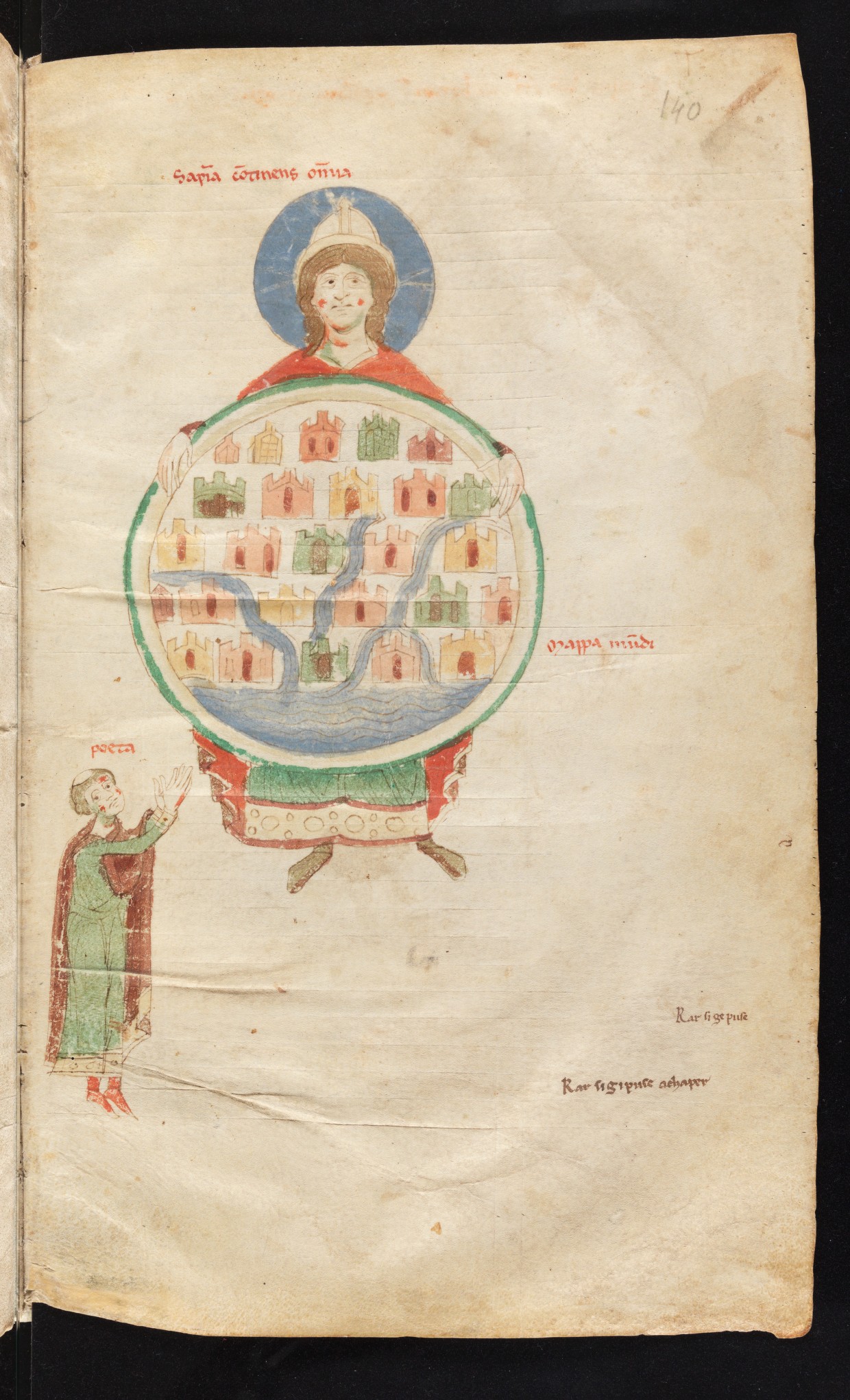
Wisdom holding a Map of the World, from Petrus de Ebulo: Liber ad honorem Augusti (Bern, Burgerbibliothek, Cod. 120.II, fol. 140r)
Registration for the Nov. 17 Index conference “Out of Bounds: Exploring the Limits of Medieval Art” is now open. Lectures will take place in 101 McCormick Hall on the Princeton University campus between 9-5, with a reception to follow in the Palmer House. Registration is free but required to guarantee a seat. For details about the conference, please check the event web page at https://ima.princeton.edu/conferences/. We look forward to seeing you!
cordially invites you to join us for our
Thursday, September 20, 2018
4:00-6:00 pm
McCormick Hall, A Level
Join us for refreshments, meet the Index staff, and catch up with the medievalist community.
Enter a raffle to win books on medieval art.
Learn how the Index can support your research!
54th International Congress on Medieval Studies, Kalamazoo, MI, May 9 to 12, 2019
Sponsored by the Index of Medieval Art, Princeton University

Organizers: M. Alessia Rossi and Jessica Savage (Index of Medieval Art, Princeton University)
Stemming from the launch of the new database and enhancements of search technology and social media at the Index of Medieval Art, this roundtable addresses the many ways we encounter medieval iconography in the twenty-first century. We invite proposals from emerging scholars and a variety of professionals who are teaching with, blogging about, and cataloguing medieval iconography. This discussion will touch on the different ways we consume and create information with our research, shed light on original approaches, and discover common goals.
Participants in this roundtable will give short introductions (5-7 minutes) on issues relevant to their area of specialization and participate in a discussion on how they use online resources, such as image databases, to incorporate the study of medieval iconography into their teaching, research, and public outreach. Possible questions include: What makes an online collection “teaching-friendly” and accessible for student discovery? How does social media, including Twitter, Facebook, and blogging, make medieval image collections more visible? How do these platforms broaden interest in iconography and connect users to works of art? What are the aims and impact of organizations such as, the Index, the Getty, the INHA, the Warburg, and ICONCLASS, who are working with large stores of medieval art and architecture information? How can we envisage a wider network and discussion of professional practice within this specialized area?
Please send a 250-word abstract outlining your contribution to this roundtable and a completed Participant Information Form (available via the Congress Submissions website: https://wmich.edu/medievalcongress/submissions) by September 15 to M. Alessia Rossi (marossi@princeton.edu) and Jessica Savage (jlsavage@princeton.edu). More information about the Congress can be found here: https://wmich.edu/medievalcongress.
Fourth in a series of short blog posts introducing new features of our online database

Did you know that you can filter Index search results by style and/or culture of origin? The “Style/Culture” field on the search filters page groups results according to widely used stylistic or cultural categories, such as “Gothic,” “Ethiopian,” or “Jewish.”
As any student of art history knows, stylistic and cultural labels can be difficult to define. Stylistically speaking, what’s “Gothic” in France in 1150 may be considered “Romanesque” at the same date in Italy, while the parameters for ethnic, religious, or other cultural communities can vary even more dramatically. Still, because we’ve observed that students and other new users of the Index may find such labels helpful in narrowing and exploring search results, we’ve elected to keep them in our new database, consulting authorities such as the Getty Art and Architecture Thesaurus and even current medieval art textbooks to refine how we apply them. If you’d like to learn more about why we applied a particular “Style/Culture” label to a work of art, you can look at the authority record for that label.
Because style and culture terms remain subjective even in the best of circumstances, they may not yield precise results and are most usefully applied when you are searching broadly to learn how a subject was represented in a particular period or cultural sphere, rather than to search for a particular example. You might find, for example, that searching for a frequently represented subject such as “Virgin Mary: Annunciation” delivers an intimidating 2500+ results. However, if what you really wanted was to see examples of how the Annunciation was depicted in Byzantine art, narrowing the results by using the “Style/Culture” delimiter “Byzantine” reduces this to a much more manageable—and more relevant—list of 276 records.
Some delimiters will still deliver a high number of results (try using “Gothic” instead of “Byzantine” to see what we mean), but you can refine these further by using additional filters—such as Date, Location, or Medium—when you’re ready for more specificity. To apply the Style/Culture filter, type a search term into the free text field at the upper right of the search window. On the results page, choose the “Filters” option, then in the “Style/Culture filter, begin typing the term you’re looking for—the system will auto-complete the term, if it exists—and then, once you’ve selected the term you want, simply click “Search.” The filtered results will appear below.
If you’d like to view a complete list of Style/Culture terms currently used by the Index, click on “Browse” at the top of the window and then choose Style/Culture. To expedite your search for a particular term, type it into the search line at the top of the list.
As always, if you have questions or comments about the Index of Medieval Art database, please contact theindex@princeton.edu. We’re here to help, and we want to know what you think.
Third in a series of short blog posts introducing new features of our online database
Have you tried out our Medium filter yet? As part of our ongoing series introducing specific features of our database to assist you in developing research strategies, let us direct your attention to the Medium field. First, you may ask, what exactly do we mean by “Medium”? In the Index database, “Medium” refers both to the materials that compose the work of art and to the methods of facture or technique employed in its creation. As Herbert Kessler rightly observes, “matter mattered in the Middle Ages,” and we at the Index wish to foster exciting new scholarship related to the iconography of materials.[1] A cursory glance at our Medium category under the “Browse” tab reveals an extraordinary array of materials and techniques. Objects may include materials ranging from “acacia” wood to “zeiler sandstone,” and all these materials might have been “hammered” and “punched,” or “chiseled” and “incised,” or subjected to many other possible means of manipulation.
But what if you are not ready for this level of specificity? For more general Medium searches, we have devised a series of basic category terms to help you find what you need: “stone,” “gems,” “wood,” “ivory,” “metal,” “enamel,” and “textile.” For example, let’s say you’re interested in representations of the Virgin Mary in any kind of stone. A keyword search for “Virgin Mary” on the database homepage will yield thousands of results in all media. So, if you want to limit your results to images in stone, simply find the “Filters” tab under “Advanced Search” and select “stone” under the Medium filter. Click on “Search,” and you will reduce your list to 1,752 records.
Now what if you know that you’re searching for representations of the Virgin Mary in a specific kind of stone? This time, let’s say you’re looking for marble sculpture. Instead of sifting through all 1,752 records for marble examples, just try selecting “marble” in the Medium filter. This should bring your results down to a mere 410 records.
You can also try refining your search with another filter. Interested in marble representations of the Virgin produced in medieval France? Add “France” in the Location filter, and you’ll narrow your results to 55 records.
So, whether you’re searching within broad categories or examining specific materials and techniques, try using the database’s Medium filter to adjust your search to your research interests.
Here are a few additional pointers:
So, as you undertake your research with us, we hope that you’ll give the Medium filter a try. As always, please feel free to send us questions or comments about any aspect of the IMA database. Contact us at theindex@princeton.edu. Matter matters…and so does your feedback!
[1] Herbert Kessler, Seeing Medieval Art (Peterborough, Ont.: Broadview Press, 2004), 14.
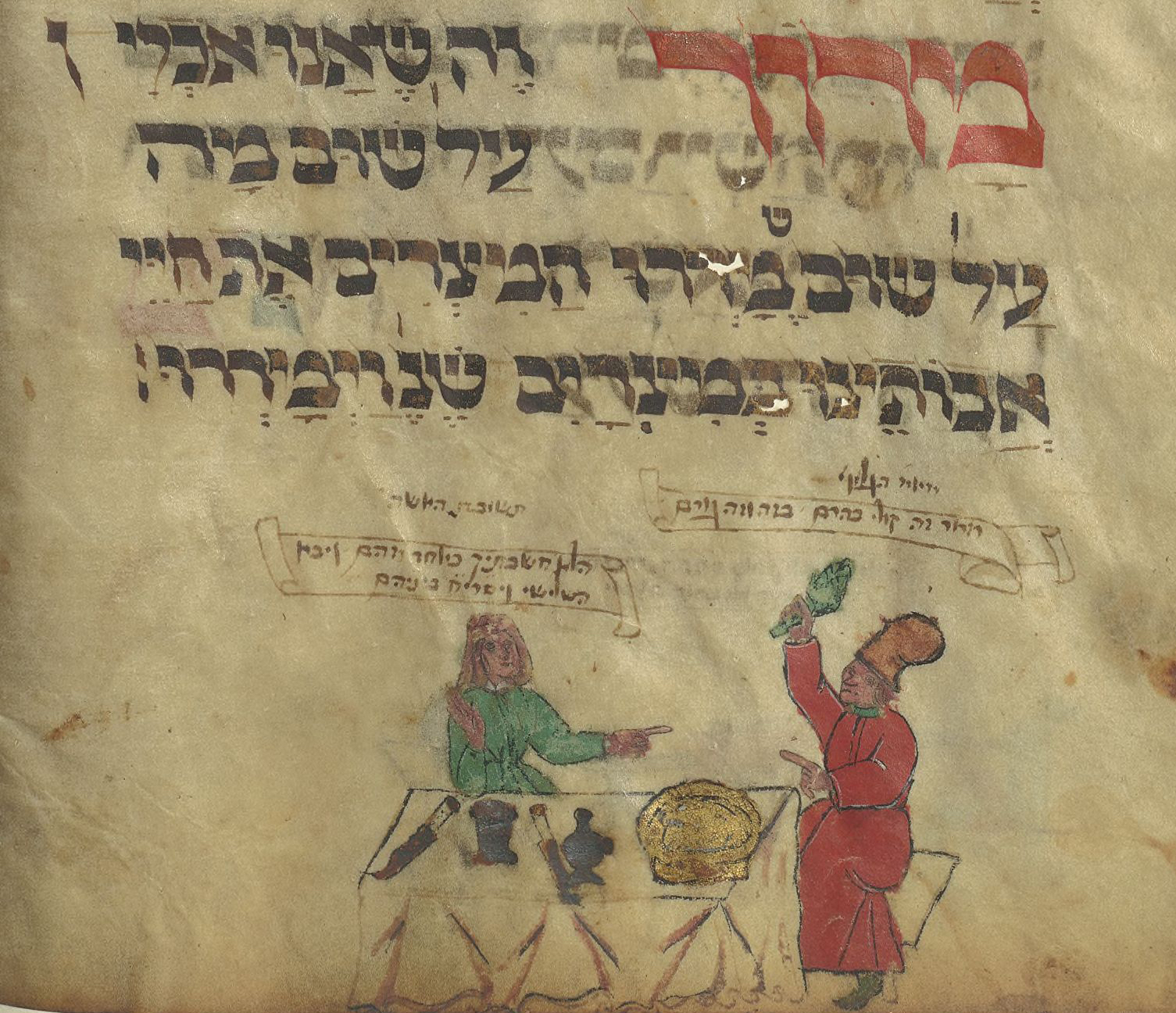
This year’s contributions are unusually diverse, ranging from Byzantine wall paintings and Romanesque sculpture to Ottonian dynastic images and Jewish ritual books. In addition, for the first time this year authors were offered the option to include color illustrations. Check out the contents of the latest volume on the updated journal page: https://ima.princeton.edu/studies-in-iconography/. Congratulations and thank you to all our authors and reviewers!
Studies in Iconography (ISSN 0148-1029) is an annual publication housed at the Index of Medieval Art at Princeton University since October 1999. It is dedicated to publishing innovative work on iconography and other aspects of visual culture of the period up to 1600. We welcome submissions of innovative work on iconography and other aspects of visual culture of the period up to 1600, including those with interdisciplinary, theoretical, and critical perspectives. Submissions are accepted year round; see https://ima.princeton.edu/studies-in-iconography-editorial-guidelines/ for current guidelines.